|
THE CROSS LANE DOWN THE
YEARS
by Rosemary McMillan
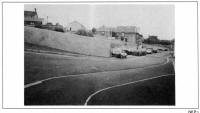 Gravity
is a powerful force, hence my scepticism regarding the
efficacy of the facelift whether applied to humans or
houses. Gravity
is a powerful force, hence my scepticism regarding the
efficacy of the facelift whether applied to humans or
houses.
Watching recent road improvements at the Gallows Street
end of Cross Lane I experienced a sense of deja-vu which
caused me to look again at old maps and records of the
locality.
According to Thomas Bell's map of Dromore for the year
1790, Lower Back Lane crossed from Gallows Street to the
Pann Close, between land owned by a Miss Vaughan, a Mr.
Waddell and one Sir Costlet Stothard. No buildings are shown
on the map but the Cross Inn is recorded on Miss Vaughan's
land south of the junction with Gallows Street and Lower
Back Lane.
Forty-four years later in 1834 on another map some
buildings are shown on the both sides of the Lane, but the
outlines are indistinct and not all of them are numbered. An
interesting feature on this map is the dotted line
representing the boundary between the townlands of
Ballymaganlis and Ballymacormick. This curious route through
the row of houses is maintained right down to the present
day. Princes Street also evolved at this time.
Valuation records of that time mention that some of the
houses are rated in one townland and some in the other.
Twenty-five years later, in 1859, the historical picture has
evolved some more house plans are clearly marked and the
tenancies recorded in the Griffiths Valuation. 1859-1863.
See Table 1 below
The areas are recorded in square yards, square poles and
roods, while the money is strictly Pounds, Shillings and
Pence!
TABLE 1
| |
|
|
|
|
RATES |
|
HOUSE NUMBER |
OCCUPIER |
IMMEDIATE LESSOR |
DESCRIPTION OF TENEMENT |
AREA |
LAND |
BUILDING |
TOTAL |
| 1 |
James Morgan
|
George M. Vaughn |
House |
|
|
15/- |
15/- |
| 2 |
Unoccupied
|
George M. Vaughan |
House |
|
|
10/- |
10/- |
| 3 |
William Stevenson
|
George M. Vaughan |
House and small
Garden |
|
|
�30"0 |
�3"0"0 |
| 4 |
Martin Doyle
|
William Miller |
House and Yard |
|
|
�1"10 sh |
�1"10 sh |
| 5 |
James Robinson |
William Miller |
House and Yard |
|
|
�1"10 sh |
�1"10 sh |
| 6 |
William Miller |
George Ruddell |
Offices/yard/small
garden |
|
|
�4"10 sh |
�4"10 sh |
| 6-11 |
VALUED
IN TOWNLAND OF BALLYMACORMACK |
|
|
|
| 6 |
David Gibson (will)
|
Reps. Howard |
Land |
10.2.10 |
�9.0.0 |
|
�9.0.0 |
| 6a |
Robert Archer |
David Gibson (Will)
|
House and Small
Garden |
|
|
�1.5.0 |
�1.5.0 |
| 6b |
John Boales |
David Gibson
" |
House and Small
Garden |
|
|
�1.5.0 |
�1.5.0 |
| 7 |
Joseph Reed |
Reps. Howard |
House Office and
Land |
6.2.15 |
�6.10.0 |
�1.0.0 |
�7.10.0 |
| 8a |
John Moore |
|
House, Office
and Land |
9.2.15 |
�7.0.0 |
�1.5.0 |
�8.5.0 |
| 8b |
Joseph Gregg |
John Moore |
House |
|
|
10/- |
10/- |
| 9 |
David Gibson |
Reps. Howard |
House, Offices and
Land |
13.1.25 |
�12.5.0 |
|
|
| 10 |
David Gibson |
Reps. Howard |
|
1.2.35 |
�1.5.0 |
|
|
| 11 |
David Gibson |
Reps. Howard |
|
23.3.0 |
�20.15.0 |
�1.10.0 |
�36.5.0 |
| |
|
|
|
|
|
|
|
The name Vaughan continues to appear in the list of
Lessors and curiously some tenants are also Lessors, but not
of the same property e.g. William Miller and David Gibson.
During the next twenty years, in the 1870's some of the
buildings, notably numbers 1, 2 and 3 are listed as being in
ruins or dilapidated and by the 1890's are designated
building ground.
See Table 2 and 3 following
TABLE 2 - 1878
| |
|
|
|
|
|
| HOUSE
NUMBER |
OCCUPIER |
LESSOR |
DESCRIPTION OF TENEMENT |
RATES |
YEAR |
| 1 |
James Morgan |
George M. Vaughan |
Ruins |
15/ - |
1869 |
| 2 |
Unoccupied |
George M. Vaughan |
Ruins/Dilapidated |
10/ - |
Reduced to 5/- in 79 |
| 3 |
William Stevenson |
George M. Vaughan |
House and Garden |
�3. 0.0 |
1873 |
| 4 |
Martin Doyle |
William Miller |
House and Yard |
�1.10.0 |
|
| 5 |
James Robinson |
William Miller |
House and Yard |
�1.10.0 |
|
| 5a |
William Miller |
George Ruddle |
Office/Garden/Small Yard
|
�4.10.0 |
�2.00 in 1870 |
| 6 |
Eliza J. Hammond |
George M. Vaughan |
Stores and Yard |
�5. 0.0 |
1873 - 75 |
| 7 |
Robert Kane |
Francis Murphy |
House |
�1. 0.0 |
|
| 8 |
James McDonnell |
George M. Vaughan |
House and Garden |
�2. 5.0 |
|
| 9 |
John Brown |
George M. Vaughan |
House and Garden |
�2. 5.0 |
|
| 9a |
Lodgers |
George M. Vaughan |
House and Garden |
�3.15.0 |
|
| 9b |
Lodgers |
George M. Vaughan |
House and Garden |
�2.10.0 |
|
| 9c |
Jas. Reynolds |
George M. Vaughan |
House and Yard |
�2.10.0 |
|
| 9d |
John Chillan |
George M. Vaughan |
House and Yard |
�2.10.0 |
|
| 9e |
Robt. Armstrong |
George M. Vaughan |
House and Yard |
�2.10.0 |
|
| 10 |
Valued with No. 17 |
Gallows Street |
|
|
|
| 11 |
Valued with No. 18 |
Gallows Street |
|
|
|
TABLE 3 - 1890
| HOUSE
NUMBER |
OCCUPIER |
LESSOR |
DESCRIPTION OF TENEMENT |
RATES |
| 1 |
|
|
|
|
| 2 |
BUILDING GROUND |
|
|
|
| 3 |
|
|
|
|
| 4 |
Joseph Andrew |
Robert S. Edgar |
House and Yard |
�4. 0.0 |
| 5a |
Mrs. Gamble |
Robert S. Edgar |
House and Yard |
�4. 0.0 |
| 5b |
Ellen White Henry Price
1891 |
Robert S. Edgar |
House and Yard |
�4. 0.0 |
| 6a |
Margaret White Thomas
Prenter 1886 - 1891 |
Robert S. Edgar |
House and Yard |
�4. 0.0 |
| 6b |
J. McCullough James
Milseed 1886 - 1891 |
Robert S. Edgar |
House and Yard
|
�5. 0.0 |
| 6c |
Jeremiah Cleland
Vacant 1886 - 91 |
Robert S. Edgar |
House and Yard |
�5. 0.0 |
| 6d |
James Black |
Robert S. Edgar |
House and Yard |
�5. 0.0 |
| 7 |
Robert Kerr |
Francis Murphy |
House |
�1. 0.0 |
| 8 |
Jas. Donnell |
Geo. M. Vaughan |
House and Garden |
�2. 5.0 |
| 9 |
James Brown |
Geo. M. Vaughan |
House and Garden |
�2. 5.0 |
| 9a |
Lodgers |
Geo. M. Vaughan |
House and Garden |
�3.15.0 |
| 9b |
Lodgers |
Geo. M. Vaughan |
House and Garden |
�2.10.0 |
| 9c |
Jas. Reynolds |
Geo. M. Vaughan |
House and Yard |
�2.10.0 |
| 9d |
John Chillan |
Geo. M. Vaughan |
House and Yard |
�2.10.0 |
| 9e |
Robert Armstrong |
Geo. M. Vaughan |
House and Yard |
�2.10.0 |
| 10 |
Valued with No.
17 Gallows Street |
|
|
| 11 |
Valued with No. 18
Gallows Street |
|
|
The maps of the period are well worn and indistinct. Map
C. shows an almost continuous line of dwellings on the South
side of Back Lane.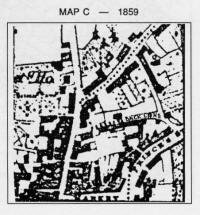 They cover most of what later became the entrance to Inn
Gardens and if we look at Map D. we can see the space left
when numbers 1, 2 and 3 were demolished. This map also
indicates a re-numbering of the houses on the South side.
They cover most of what later became the entrance to Inn
Gardens and if we look at Map D. we can see the space left
when numbers 1, 2 and 3 were demolished. This map also
indicates a re-numbering of the houses on the South side.
Subdivision or subletting of number 9, the building shown
on the North side, is revealed by valuations for 9a, 9b, 9c,
9d and 9e11 all of which eventually become numbers 12 and
13. Lodgers are listed as living at 9a and 9b. In 1878
number 6 is listed as stores and yard by 1890 it has become
6a, 6b, 6c and 6d each being a house and yard. The corner
site to the West between Gallows Street and Back Lane, the
approximate area of the Cross Inn, is occupied first by the
Court House and then by a Protestant Hall.
In Basset's County Down 1886, we are told that "within
the last fifteen years there has been a great change for the
better in Dromore. A desire to give it prominence among the
principal county towns has been manifest in various ways.
The appearance of the business houses has been very much
improved, and the new houses added during the time mentioned
constitute fully a third of the number inside the boundary."
I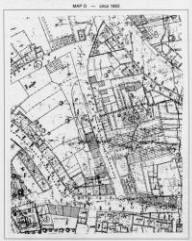 t is also said that "among the houses re-built in the
square that of Mr. Robert S. Edgar is the finest." In the
evaluation lists for 1890 for Back Lane his name appears
prominently among the Lessors along with that of George M.
Vaughan and Francis Murphy. See Table 4 below. These three
family names continue in the valuation lists right down to
the 1930's. Whether his interest in building went as far as
to improve numbers 4-6 is speculative, but the valuations on
4, 5a and 5b increase to �4. t is also said that "among the houses re-built in the
square that of Mr. Robert S. Edgar is the finest." In the
evaluation lists for 1890 for Back Lane his name appears
prominently among the Lessors along with that of George M.
Vaughan and Francis Murphy. See Table 4 below. These three
family names continue in the valuation lists right down to
the 1930's. Whether his interest in building went as far as
to improve numbers 4-6 is speculative, but the valuations on
4, 5a and 5b increase to �4.
At the turn of the century number 9 became building
ground but otherwise the Lane appears to have entered a
period of stability the rating value of number 4-7, now
renumbered, 1-8, has fallen by between ten shillings, and
one pound ten shillings.
This permanence is also reflected in the names of the
occupiers where the tenancy appears to pass down the family,
for example Donaldson in number 1, Lilley in number 6, Quinn
in number 4, Agnew in number 5 (although he seems to have
moved next door!) are other long stay names. See Tables 4, 5
and 6 following.
TABLE 4
| HOUSE
NUMBER |
OCCUPIER |
IMMEDIATE LESSOR |
DESCRIPTION OF TENEMENT |
RATES |
YEAR |
| 1 |
Thomas Donaldson
|
Eliza J. Edgar |
House and Yard |
�3.0.0 |
1901 - 09
Reduced from �4 |
| 2 |
? Poots |
Eliza J. Edgar |
House and Yard
|
�3.0.0 |
1901 - 10
Reduced from �4 |
| 3 |
Robert Smyth |
Eliza J. Edgar |
House and Yard
|
�3.0.0 |
1905 - 09
Reduced from �4 |
| 4 |
Samuel Agnew |
Eliza J. Edgar |
House and Yard |
�3.10.0 |
1903 - 10
Reduced from �5 |
| 5 |
Sarah Coburn |
Eliza J. Edgar |
House and Yard
|
�3.10.0 |
1903 - 09
Reduced from �5 |
| 6 |
Anthony Lilly |
Eliza Coburn |
House and Yard |
�3.10.0 |
1901 - 10
Reduced from �5 |
| 7 |
(Ina?) Hodgen |
Eliza J. Edgar |
House and Yard |
�3.10.0 |
1901 - 09
Reduced from �5 |
| 8 |
? Houston |
Frances Murphy |
Office |
10/- |
Reduced from �1 |
| 9 |
Building Ground |
|
|
|
|
| 10 |
Lizzie Close |
Rev. G.H. Vaughan
|
House and Small Garden |
�2.5.0 |
1906 |
| 11 |
Mgt. Maginnis
|
Rev. G.H. Vaughan |
House and Small Garden |
�2.5.0 |
1904 |
| 12 |
? Duggan |
Rev. G.H. Vaughan |
House and Small Garden
|
�2.0.0 |
1901
Reduced from �3.15 |
| 13 |
Thomas Poots |
Rev. G.H. Vaughan |
House and Small Garden
|
�2.10.0 |
1901 |
| 14 |
Peter Magill Rev. |
G.H. Vaughan |
House and Yard |
�2.10.0 |
1901 |
| 15 |
Alex Boyle |
Rev. G.H. Vaughan |
House and Yard |
�2.10.0 |
1901 - 06 |
| 16 |
? Gorman |
Rev. G.H. Vaughan |
House and Yard |
�2.10.0 |
1901 |
An interesting point is the number of houses which were
unoccupied during the First World War - no less than five
out of the sixteen available. It is not until 1946 that the
name change to Cross Lane is shown on an Ordnance Survey
map. It seems to have heralded in the penultimate phase in
the life of the lane.
TABLE 5
| HOUSE
NUMBER |
OCCUPIER |
LESSOR |
DESCRIPTION OF TENEMENT |
RATES |
YEAR |
| 1 |
Thos. Donaldson |
Eliza J. Edgar |
House and Yard |
�3. 0.0 |
|
| 2 |
Herbert Greer |
Eliza J. Edgar |
House and Yard |
�3. 0.0 |
1911 - 1919 |
| 3 |
Alice Magill |
Eliza J. Edgar |
House and Yard |
�3. 0.0 |
1912 |
| 4 |
Catherine Quinn |
Eliza J. Edgar |
House and Yard |
�3.10.0 |
1914 |
| 5 |
Samuel Agnew |
Eliza J. Edgar |
House and Yard |
�3.0.0 |
1913 |
| 6 |
Anthony Lilley |
EIiza J. Edgar |
House and Yard |
�3.10.0 |
|
| 7 |
Robert Fairley |
Eliza J. Edgar |
House and Yard |
�3.10.0 |
1917 |
| 8 |
John Houston |
Francis Murphy |
Office |
10.0 |
|
| 9 |
Building Ground |
|
|
|
|
| 10 |
Vacant . |
Rev. G. H |
House and Garden |
�2. 5.0 |
1913 |
| 11 |
Vacant |
Vaughan |
House and Garden |
�2. 5.0 |
|
| 12 |
Vacant |
" |
House and Garden. |
�2. 0.0 |
1913 - 1915 |
| 13 |
Vacant |
" |
House and Garden |
�2.10.0 |
1913 - 1915 |
| 14 |
Mary McCrory |
" |
House and Yard |
�2.10.0 |
1916 - 1918 |
| 15 |
Thomas Mackin |
" |
House and Yard |
�2.10.0 |
1911 - 1918 |
| 16 |
Vacant |
" |
House and Yard |
�2.10.0 |
1913 - 1915 |
In the 1950's the houses were condemned and the tenants
offered a resettlement grant. As they moved out the houses
were demolished.
TABLE 6
| HOUSE
NUMBER |
OCCUPIER |
LESSOR |
DESCRIPTION OF TENEMENT |
RATES |
YEAR |
| 1 |
Katherine Donaldson |
Mary Edgar |
House and Yard |
�3. 0.0 |
1923 |
| 2 |
Robert Poots |
Mary Edgar |
House and Yard |
�3. 0.0 |
1921 - 23 |
| 3 |
Margaret Thompson |
Mary Edgar |
House and Yard |
�3. 0.0 |
1922 |
| 4 |
Catherine Quinn |
Mary Edgar |
House and Yard |
�3.10.0 |
|
| 5 |
Samuel Agnew |
Mary Edgar |
House and Yard |
�3.10.0 |
|
| 6 |
Anthony Lilley |
Mary Edgar |
House and Yard |
�3.10.0 |
|
| 7 |
John Hamilton |
Mary Edgar |
House and Yard |
�3.10.0 |
1920 - 25 |
| 8 |
John Houston |
Francis Murphy |
Office |
10.0 |
|
| 9 |
Building Ground |
|
|
|
|
| 10 |
Vacant |
Representative |
House and Garden |
�2. 5.0 |
|
| 11 |
John Hyland |
of Rev. G. H. |
House and Garden |
�2. 5.0 |
|
| 12 |
Isaac Martin |
Vaughan |
House and Small Garden |
�2. 0.0 |
1922 - 30 |
| 13 |
Michael McCreesh |
" |
House and small Garden |
�2.10.0 |
1922 - 30 |
| 14 |
Thomas Doonan |
" |
House and Yard |
�2.10.0 |
1924 |
| 15 |
Samuel J. Davis |
" |
House and Yard |
�2.10.0 |
1930 |
| 16 |
Mary Poats |
" |
House and Yard |
�2.10.0 |
1920 - 30 |
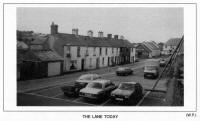 For
over two hundred years the Lane had evidenced both
development and decay, now only seven houses remain as
testimony to its populous Victorian hey-day. Open spaces,
albeit in the form of car parks, have returned. It is
perhaps significant, that they accommodate re-cycling bins,
for re-cycling is the name of the game in Cross Lane at
present. Surface features may have been re-modeled but the
basic shape and function, that of a short cut, remains
unchanged. For
over two hundred years the Lane had evidenced both
development and decay, now only seven houses remain as
testimony to its populous Victorian hey-day. Open spaces,
albeit in the form of car parks, have returned. It is
perhaps significant, that they accommodate re-cycling bins,
for re-cycling is the name of the game in Cross Lane at
present. Surface features may have been re-modeled but the
basic shape and function, that of a short cut, remains
unchanged.

BOOK REVIEW
"A HISTORY OF ULSTER" by Jonathan Bardon, Blackstaff Press,
Hardback �30.00. Paperback �14.95. 914 pages.
This book is perhaps the most valuable one to have
appeared in recent years and one which any local historian
ought to read. Grey Gowrie in his review of the book states,
"The story is an old one and I doubt it will ever be better
told. Jonathan Bardon has two great strengths, he is a good
writer and a natural storyteller." He tells how Brian
O'Neill invaded Down in 1260 and of the Anglo Normans who
built Mottes (such as the one in Dromore) on the Earl of
Ulster's frontiers to guard and help defend the King at home
and abroad.
In 1315 Scots landed at Larne led by Robert Bruce and
Edward Bruce to capture Ireland but due to famine in 1317, a
cattle and sheep plague, they retreated in 1363.
In 1563 Shane O'Neill fought the MacDonnells and in 1565
he advanced to Dromore and waited for his kinsmen to join
him. During the Rebellion of 1641, Dromore was burned and
Portadown fell.
In 1689 Monaghan, Down and Antrim resisted Tyrconnell.
Richard Hamilton, a Jacobite, overwhelmed the Protestants,
led by Arthur Rawdon of Moira, at Dromore on 14th March,
1689. The rest of Eastern Ulster fell and Hillsborough,
Lisburn, Antrim and Belfast were plundered. King James
arrived in Dublin on 12th April and reached the walls of
Derry on 18th April 1689. The rest is well known history. We
are told that in 1800, Dromore was a neglected town
consisting of only a few mud-cabins. -May Wilson.
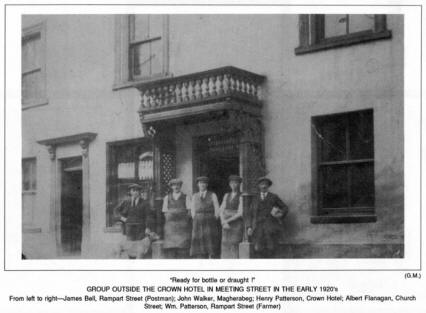
"Ready for bottle or draught l" GROUP OUTSIDE THE CROWN
HOTEL IN MEETING STREET IN THE EARLY 1920's From left to
right-James Bell, Rampart Street (Postman); John Walker,
Magherabeg; Henry Patterson, Crown Hotel; Albert Flanagan,
Church Street; Wm. Patterson, Rampart Street (Farmer)
 |